|
 Inonotus nothofagi Inonotus nothofagi
SynonymsPolyporus radians
Polyporus radiatus
BiostatusPresent in region - Indigenous. Endemic
Images (click to enlarge)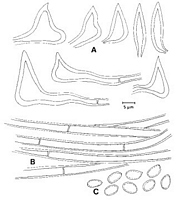
Caption: Fig. 12. Inonotus nothofagi. A, setae; B, generative hyphae; C, spores. From the type (PDD 5795). | 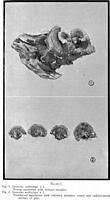 | 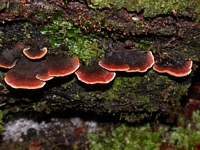
Caption: Inonotus nothofagi
Owner: Nils Hallenberg | 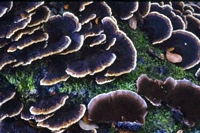 | 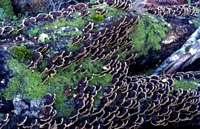
Owner: P.K. Buchanan |
Article: Buchanan, P.K.; Ryvarden, L. (1988). Type studies in the Polyporaceae - 18. Species described by G.H. Cunningham. Mycotaxon 31(1): 1-38.
Notes: Accepted as Inonotus nothofagi.
As stated by Cunningham (1965), this species is related to I. radiatus (Sow.: Fr.) P. Karst. of the
Northern Hemisphere, but is easily separated by the coloured spores and straight setae. It is
confined to Nothofagus. Cunningham (1965) included collections on Quercus from India under I.
nothofagi but these were later redetermined as I. diverticulosepta Pegler (Pegler, 1967).
Article: Cunningham, G.H. (1948). New Zealand Polyporaceae. 7. The genus Inonotus. New Zealand Department of Scientific and Industrial Research, Plant Diseases Division, Bulletin 78: 5 p.
Description: Hymenophore annual, sessile, dimidiate, firm and woody but brittle. Pileus applanate, when
attached by a broad base, more often effused-reflexed, or conchate when attached by a narrow
base, sometimes resupinate, 1.5-3.5 cm. x 1.5-3 cm. x 2-4 mm.; surface ferruginous, umber,
or black, lighter in colour peripherally, radiately striate, concentrically sulcate, smooth and
polished save at margins where somewhat tomentose, cuticle 25-100 µ thick, of densely
arranged parallel hyphae cemented with mucilage, walls chestnut-brown, in old plants thin,
black and shining; margin at first tan or bay-brown, acute, inturned, lobed, torn, in old
specimens often abrupt and concolorous; hymenial surface ferruginous, becoming umber,
even, fertile to the edge, dissepiments toothed. Context 0.2-2 mm. thick, at first fulvous,
becoming ferruginous, of densely packed parallel brown hyphae; generative hyphae ribbon-like, 5-7 µ thick, wall 0.5 µ, scantily septate save in the hymenium, sparsely branched. Pores irregular, angular or linear, to 2.5 mm. deep, ferruginous in section, 100-400 µ diameter, or 2-5 per mm.; dissepiments 50-150 µ thick, most 75 µ, equal, apex sometimes tapering, finely
tomentose. Setae ventricose, chestnut-brown, 20-26 x 10-12 µ, abundant. Basidia oblong, 6-8
x 2.5-4 µ, soon collapsing. Spores broadly elliptical 5-6 x 3-3.5 µ, smooth, ferruginous,
abundant.
Habitat: HABITAT: Growing imbricate on bark or decorticated wood of standing trees, associated
with a white rot.
Distribution: DISTRIBUTION: New Zealand.
Notes: In a former paper (Trans. N.Z. Inst., vol. 58, p. 241, 1927) I listed the species under
Polyporus radiatus (Sow.) Fr. since collections forwarded to the late C.G.Lloyd and J.R.Weir
were so named by them, despite the coloured spores. Since then many additional collections
have come to hand; and as in all spores are definitely brown, it is evident that this feature is
constant for the species. I have also been able to compare our collections with I. radiatus, I.
cuticularis, I. rheades and I. ludovicianus. All possess a monomitic hyphal system, long
ribbon-like thin-walled brown generative hyphae (which are without clamp connections),
honeycomb basidial type and brown acuminate setae. Specimens of I. radiatus from England
(Birmingham, collected by W.B.Grove, forwarded by E.M.Wakefield) and Sweden
(Vaidsatra, collected by Seth Lundell, forwarded by J.Ax.Nannfeldt) differ from the New
Zealand species in that the poorly developed cuticle is concolorous with the context, spores
are hyaline, setae are scanty--a half dozen at most being seen in the field of the microscope
in contrast with the scores seen in New Zealand collections. I. cuticularis (from Fagus sp.,
Kew Gardens, collected by E.M.Wakefield) is readily identified by the unusual cuticle, which
is composed of a dense tomentnm of chestnut-brown dendroid compound setae, branches of
which are hamate. Spores are brown and 5-7 x 4-5 µ. I. rheades (from Quercus spp., West
Okoboji and Iowa City, U.S.A., forwarded by G.W.Martin) possesses a striaose surface and is
without a cuticle; spores, though brown, are larger than those of our species (5-8 x 4.5-6 µ). I.
ludovicianus (from Wauchope, New South Wales, forwarded by J.B.Cleland) was held by the
late C.G.Lloyd to be a thin form of I. cuticularis. It differs from this last in being without a
definite cuticle. It differs also from I. nothofagi in this feature, in larger pilei, different colour
of context and pores, and differently shaped spores.
The New Zealand species would therefore appear to be undescribed. It is apparently confined
to species of Nothofagus and may be recognised by the small dark pileus with (when old)
almost black surface and abrupt margin, definite shining black cuticle, pores 2-5 per mm.,
ferruginous broadly elliptical spores and abundant ventricose setae.
|